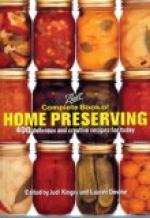The broom should be of about medium weight, held almost perpendicularly and passed over the carpet with a long, light stroke and steady pressure which will not scatter the dirt, and turned every few strokes that both sides may receive equal wear. Steps can be saved by sweeping to a central point, going with the nap of the carpet, never against it, taking special care to dislodge the dust which gathers between the edges of the carpet and the baseboard. Shreds of dampened paper, or damp bran scattered over the carpet facilitate its cleaning; or in lieu of these the broom may be wet and shaken as free from water as possible before using. Any method of keeping down the dust saves much cleaning of woodwork, walls, and pictures. Rugs are swept in the same way as carpets. After they are cleaned the edges are turned up and the bare floor gone over with a long-handled hair brush, or with a broom covered with a Canton-flannel bag. If the floor is painted, follow the duster with a damp cloth; if hardwood, rub well with a flannel slightly moistened with crude oil and turpentine. Small rugs are taken out of doors and shaken or beaten. They must be held by the sides, never by the ends. Matting should be swept with a soft broom and wiped over with a damp cloth, using as little water as possible, and no soap, which stains and discolors it. Rubbing with a cloth wrung out of hot water will usually take out the spots which the regular cleaning has failed to remove, while grease spots yield to the application of a thin paste of fuller’s earth left for three days and then brushed off. Rooms not in daily use do not need a thorough sweeping oftener than every two weeks, a whisk broom and carpet sweeper sufficing between times.
While the dust is settling put a fresh bag or a clean, soft duster on the broom and brush off ceiling and walls, using a straight downward stroke for the latter. The cloth must be renewed when it becomes soiled. A long-handled feather duster is handy for cleaning moldings and cornices. This, by the way, is the only legitimate use to which a feather duster can be put, in addition to dusting books and the backs and wires of pictures. Instead of taking up the dust, it simply sets it free to settle elsewhere, making a lingering trouble, long drawn out; for though one may whisk around with it and then enjoy the conscious virtue which comes with having “one more thing out of the way,” the complacency is short-lived and the cheesecloth duster finally has to come to the rescue. All dusters should be hemmed, otherwise the ravelings are apt to catch and pull down the bric-a-brac. After the walls Phyllis dusts the woodwork and goes over it with a clean, damp cloth, not omitting doorknobs, and looking out for finger marks in likely places. If these are stubborn, a little kerosene in the cleaning water will help on the good work. She brushes and wipes off the window casings and gas fixtures, dusts and replaces the furniture, polishes the mirrors,




